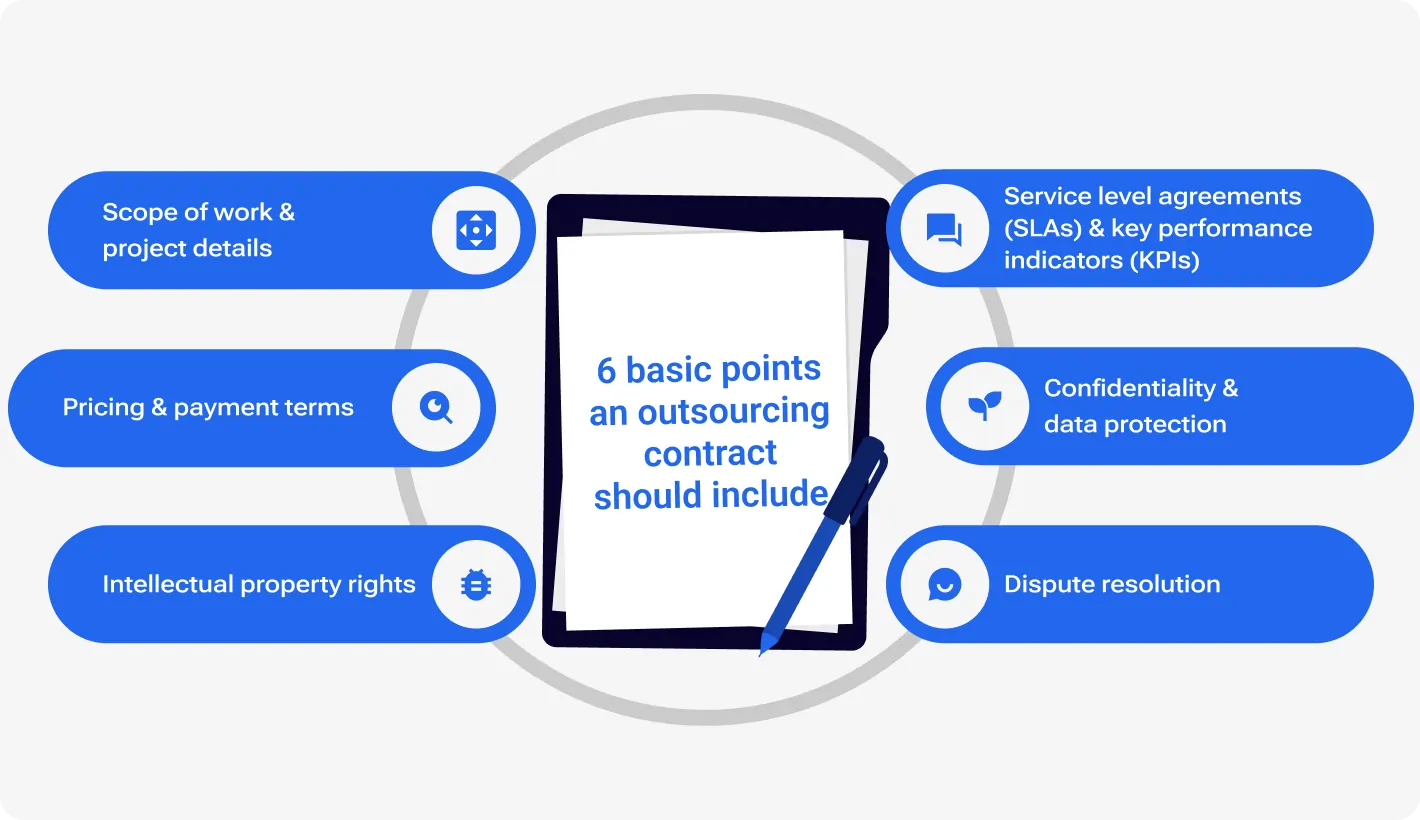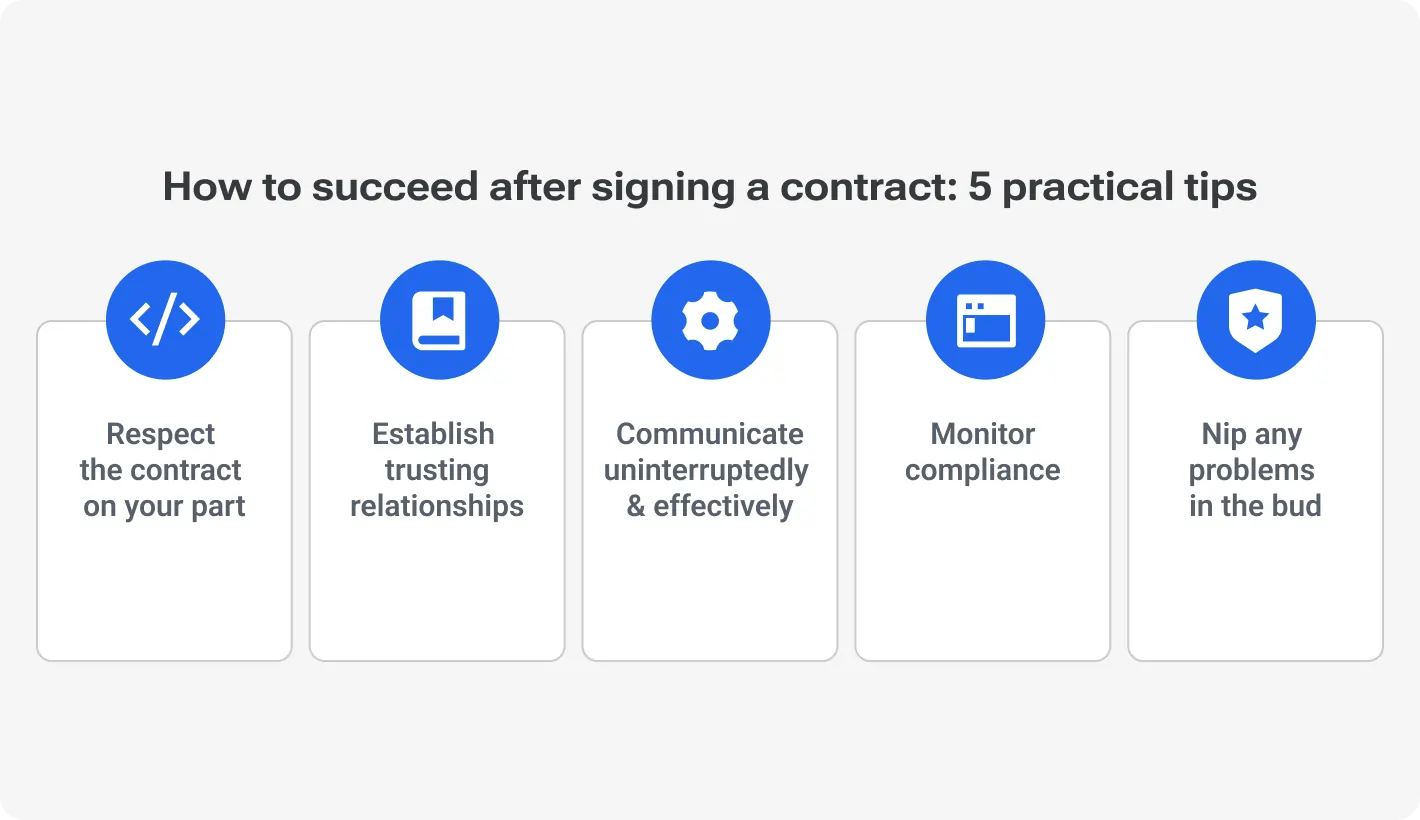Do you want to experience all the advantages of outsourcing, such as budget savings, reduced time-to-market, and increased productivity, but are afraid of the risks? Having a well-prepared contract with a partner IT company can help keep you safe. From this article, you will find out:
what outsourcing contracts should be like;
what elements it should consist of;
what pitfalls you may encounter and how to avoid them;
6 basic points an outsourcing contract should include
Do you want to start working with an external IT team for the first time? Most likely, you do not know yet what the outsourcing agreement should be like. Below, you can find the main components that should compulsorily be included in the contract.
Scope of work and project details
First of all, the document should contain the details of the project the team is going to work on. The more specifics you describe, the better the final result of the work will be. You need to include the following information:
What business goals you want to achieve;
What tasks should be accomplished (in as much detail as possible);
What the final result should look like (if it is the development of some product, how it should work, and what features it must necessarily have);
What should be the stages of the project (if it is large, it can be divided into several smaller ones).
End-to-end solutions with predictable budgets, a time-to-market advantage with budget savings of up to 50%
It is also crucial to be forward-looking when preparing a contract. The world does not stand still, and if the project is long-term, some circumstances may change during its implementation, and, accordingly, your business goals may be adjusted.
Therefore, it is important to agree in advance on how you and your company will act if requirements change, new wishes are added to the project, or it scales up or down. Discussing these issues beforehand can help you avoid serious misunderstandings and failures in the future.
Service level agreements (SLAs) and key performance indicators (KPIs)
These are essential points. Specifying them in detail will allow partners to understand clearly your expectations of working with them.
What are SLAs?
SLAs are a description of:
The details on the services that the partner undertakes to provide to you. For example, the tasks the engineers are going to accomplish for you, the specifications of the ready-made product, etc.
The standards the team will have to adhere to. Some organizations that already have an internal IT team but want to complement and strengthen it with an outsourced team may have their own code-writing standards. If you have them, you should be sure to outline them in the contract, so that the external professionals learn them and adhere to them, keeping the entire job in the same style.
The level of quality that the final result should have (measured by key performance indicators). Everyone's understanding of high quality is different. For your expectations and the company's capabilities to match, you need to discuss the details of the expected KPIs in advance and register them in the agreement.
The basics of KPIs
Different companies prefer various criteria for evaluating the quality of work. However, in the table below you can find the most common KPIs for software development.
5 essential software development KPIs
KPI
What it stands for
How it is calculated
The scope of work done during a sprint.
The number of story points / the number of hours (days, sprints) spent.
The speed of completion of a certain set of tasks.
The number of hours or days it took to finish a certain amount of work.
The frequency of code changes.
The number of changed code lines / the total number of code lines * 100%.
The number of bugs in the product.
The number of identified bugs / the number of conducted tests.
How often code is deployed into production.
The number of deployments made in a certain period of time (e.g. month) / the number of days in that period of time (e.g. 30).
How to monitor SLAs and KPIs?
You need to describe the quality standards and the metrics for their measurement not for fun, but in order to monitor them during the work process. So that you can track them effectively, discuss in advance the frequency and format of the reports that the external IT team will provide to you, and specify it in the contract.
Pricing and payment terms
To be able to clearly plan your budget, all financial details should be discussed and included in the contract. The document should contain information about payment terms and its schedule, including milestones, invoicing, and deadlines.
A broad variety of options for payment terms are used in outsourcing. The most common models are described below.
Fixed-price
The main benefit of this option is the ability to plan your budget as accurately as possible. You agree on a fixed price that will not change. However, in such a case you must provide in advance the most precise information about the work to be ordered: how much and exactly what services you want to get. Significant changes in wishes and requirements in the course of the work are not appropriate with this payment model.
Time and material
With this option, the payment is calculated depending on the working hours spent (hours are multiplied by a corresponding, agreed-upon rate), as well as the cost of materials spent (in IT, it can be, for example, subscriptions to the tools necessary for work, amortization of working equipment, etc.).
The main advantage of this model is its flexibility. It is perfectly suitable for developing projects from scratch, when requirements may change in the course of work. It is also good for long-term projects, because the business strategy can be adapted to market changes, and, accordingly, new requirements for IT tasks can be introduced.
Milestone-based
In this model, the customer does not pay the entire sum for the whole work at once but pays for the services gradually. Each milestone includes a certain amount of tasks (their scope and details about them should be specified in the contract as well). Payment for the agreed amount of tasks is made after they are completed and approved by a client.
This format is great for long-term projects. Gradual payment allows a client to reduce risks and optimize their budget.
Data protection and confidentiality clauses
When working with an outsourcing company, the organization may provide it with confidential information about its operations. It is also possible that sensitive customer data will also be available to external IT professionals.
So, it is crucial for any business to protect this information. Therefore, it is very important to specify in the contract how this data will be stored, processed, and protected.
In addition, companies usually sign an NDA. This ensures that confidential information about the business, as well as its intellectual property, does not end up in the hands of competitors or other third parties. Such an agreement specifies what information is considered confidential, the obligation not to disclose it, the sanctions for its disclosure, etc.
Intellectual property rights
The product of information technology is intangible and cannot be physically appropriated. However, intellectual property rights must be clearly defined. When using outsourcing services, misunderstandings may arise, as the idea belongs to the client, but the execution is entirely made by external developers. Therefore, it is important to determine in advance and specify in the contract who will own the intellectual property of the finished product.
Dispute resolution
Even if you and your partner are a perfect match and on the same page, it's impossible to foresee everything. Misunderstandings and conflicts may arise due to force majeure. Also, there is always the risk of unforeseen situations that can prevent a team from fulfilling the order.
To ensure that such circumstances do not become insurmountable, before the start of cooperation, you should think over the ways of resolving conflicts or compensation in case of failure to fulfill the order and write them down in the contract.
For effective conflict management, the contract should specify how conflicts are going to be resolved and which third parties can be involved. For example, you can choose such options as:
Mediation. It is the involvement of a third party in conflict resolution, which helps both sides to express their arguments as accurately as possible, understand each other, and reach a compromise.
Arbitration. This is putting the dispute in the hands of an independent third party who will consider the arguments of both parties and make a judgment.
Legal action. It is the resolution of conflict through official representatives (court). Since this is the strictest way of resolving misunderstandings, it is necessary to specify in the contract what exactly can be the basis for its application. It is also necessary to state which judicial body will be responsible for resolving the conflict.
The most widespread pitfalls in outsourcing contracts and the ways of avoiding them
The effectiveness of risk management in working with contractors depends on the clarity and correctness of the contract. Therefore, it is important to avoid deficiencies in the documents. In the table below, you can find the most common ones and the ways to stay away from them.
Common contract pitfalls and how to avoid them
Pitfall
Its negative impact
How to avoid it
Vague or ambiguous language
Unclear language may result in one of the parties misinterpreting the contract in its favor.
It may also prevent the outcome of the work from meeting the customer's expectations.
Use unambiguous and clear words, preferably terms and legal language that cannot be deciphered in any way other than what you meant.
If a word or a term has more than one meaning, provide a clear definition of it right in the document.
Unclear performance metrics
Vague metrics can lead to an inability to effectively monitor work productivity.
Describe SLAs and KPIs in detail.
When setting KPIs, use clear numbers that you are aiming for.
Specify how often and in what form you would like to receive performance reports.
Ill-conceived terms of termination
It can cause the inability to terminate the contract when needed.
Describe the cases in which contractual interruption is permissible.
Outline the method by which the contract will be terminated.
Provide a plan for phasing out your partner when the project ends.
Poor quality of the document due to lack of legal expertise
This can lead to very serious consequences, such as contract invalidation in terms of the law.
This, in turn, may make it impossible to use the document in court to resolve possible conflicts.
Involve professional lawyers in drafting the contract.
Give the finished agreement to an experienced lawyer for review.
Ensure that the document does not contravene industry-specific regulations and standards.
Negotiating about the contracts for outsourcing: Best practices
Before you draw up and sign a contract you need to discuss all the details and agree on the terms that will be favorable to everyone. Below, you will find some tips on how to do this.
Make an internal decision
Before you start negotiating terms with your IT service provider, make sure you have agreed on all the details within your organization. Involve all key stakeholders, including legal, finance, and operations teams, in the contract negotiation process to ensure that their views on the objectives and requirements for cooperation with an outsourcing company are aligned.
Come to a win-win solution
When discussing the contract terms, be flexible and open to compromise. Decide which requirements are the most critical and must remain unchanged, and which can be negotiated on. Balance the benefits for you and your outsourcing partner to make the best decision and establish a trusting relationship.
Document everything in written form
What has been said may be forgotten or lost in the large flow of information. To avoid misunderstandings and disputes in the future, it is better to communicate about the most important things in writing or summarize and document decisions made during oral negotiations.
Also, all the terms and conditions you come to should be written down in the contract. Writing only the basic information in the document and agreeing on the rest by word of mouth can be a huge mistake that may potentially lead to failure.
The same is true for various adjustments of the work process. If you need any changes, it is better not only to discuss it with your partner but also to document everything in the contract. And if the adjustments are very significant, you may have to sign an additional or completely new document.
How to succeed after signing a contract: 5 practical tips
Signing a mutually beneficial contract is just the beginning. But how to go through the whole cooperation path successfully? Below, you will find a few recommendations.
Respect the contract on your part
By meeting all the terms of the agreement fully and timely, you will show respect for your partners and achieve reciprocity from them. If, however, you look for loopholes or don't fully comply with the terms of the agreement, you will show the other party that this is acceptable, and they will behave the same way.
Establish trusting relationships
A formal contract is an important and integral part of cooperation. However, even in business relationships, there is always the human factor.
For cooperation to go smoothly and bring only benefits but not problems for both parties, it is necessary to build and maintain friendly and comfortable relations with partners. To do this:
communicate without excessive criticism or accusations;
respect the culture of the country where your external developers come from.
Communicate uninterruptedly and effectively
To keep being aligned, keep in touch constantly. This way, the external IT team will get into the process of working on your project faster and will always be aware of your business goals and possible changes to them. To make your communication as effective as possible, communicate through any channel you like, and don't forget to have regular calls.
Monitor contract compliance
A trusting relationship is great. But it doesn't change the fact that you need to carefully monitor the fulfillment of the contract. Monitor the quality of the work being done and track progress. Ensure that the IT service vendor provides you with regular reports at agreed times and check them.
Nip any problems in the bud
Do you see any flaws in the work done or feel that something in communication has changed and conflict may arise soon? In such cases, it is better to openly discuss the problem right away and find ways to resolve it than to let it escalate.
That's why it's crucial to regularly review performance reports and provide timely feedback on them. It is also important to have regular calls to keep up to date with the working mood of the team.
Conclusion
A proper contract is a guarantee of successful cooperation and minimization of risks associated with outsourcing. This document must necessarily contain:
comprehensive details about the services ordered and their scope;
requirements and quality standards for the fulfillment of tasks;
KPIs by which the success of the work will be measured;
details on the amount and terms of payment;
terms of data protection and confidentiality;
information on intellectual property rights;
the ways for resolving conflicts if there are any.
When drafting a contract, avoid common pitfalls, such as ambiguous language, unclear KPIs, and unforeseen conditions of termination. Also, remember to have the document reviewed by a professional lawyer to ensure it is correct and complies with industry-specific regulations.
Support your business growth with a global talent pool of experienced software engineers





